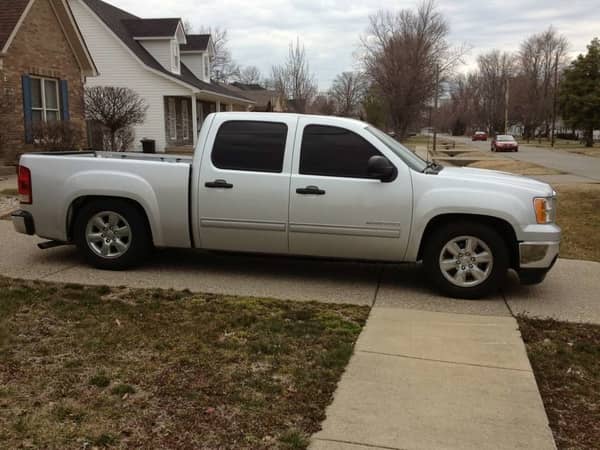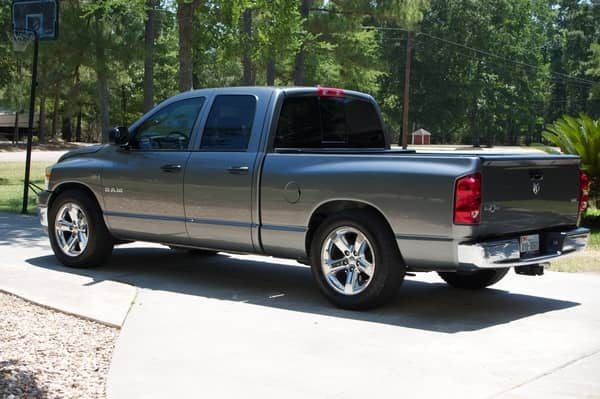If you spend any time at all driving around on streets or highways, then you have no doubt seen them – cars that have had their suspensions lowered closer to the ground, some so much so that the fenders barely clear the wheels. Some car owners lower their vehicles purely for aesthetic reasons, while others do it for improved performance. But did you know that many vehicle owners lower their pick-up trucks?
Does lowering a truck make it faster? If it is performed the right way, lowering a truck can make it more aerodynamic, which should not only make it faster but more fuel-efficient as well. Lowering a truck also drops its center of gravity closer to the ground, which can enhance handling, boost acceleration, and even improve stopping distance.
As with most vehicle customization jobs, there are caveats and trade-offs. The various improvements in performance may be significant, slight, or negligible, depending on the make and model of the truck and the type of modifications made. Also, haphazardly lowering a truck without doing the proper research can lead to unintended consequences, some of which are obvious and some that are not.

How Lowering a Truck Can Improve its Speed and Performance
With few exceptions, pick-up trucks have factory-spec suspensions when they are driven off the dealership lot. After all, the overwhelming majority of pick-up truck owners purchase these vehicles for their utility value, be it hauling large or heavy cargo, towing other vehicles, or even off-roading. As such, pick-up trucks typically have high stances with the bed of the truck sitting roughly two inches higher than the nose of the vehicle to accommodate loads.
Under this standard configuration, the typical pick-up truck is not very aerodynamic, nor is it intended to be; the emphasis is not on speed or agility, but rather, power and functionality. With a few modifications, however, a truck can be lowered anywhere from an inch and a half to over four inches from its original factory stance. Some of these changes slightly alter the original manufacturer’s components, while others replace them altogether.
In so doing, certain aspects of a truck’s performance can be enhanced or improved as a result of lowering, provided that the modifications have been made correctly.
- Improved aerodynamics – The resistance that an object encounters when moving through the air is called drag, and in the case of an 8,000-pound truck, it can be substantial. Lowering a truck can significantly reduce the amount of air moving underneath the chassis and around the wheels, thereby lessening drag and improving aerodynamics.
Thus, a lowered truck with better aerodynamics encounters less air resistance as it moves (particularly at higher speeds), and as a result, it should be faster. Furthermore, with the engine not having to work as hard as before to achieve the same speed, there will likely be an improvement in fuel efficiency (miles per gallon) as well.
- Lowered center of gravity – Depending on the particular method used to lower a truck (and there are quite a few), a drop of anywhere between one and a half to four inches in the truck’s overall height can be expected. As a truck’s height is lowered, so too is its center of gravity dropping closer to the ground, and this can have several impacts on the way the truck drives.

- A lower center of gravity enhances the driver’s feel for the road as different road conditions can be felt through the steering wheel.
- With its center of gravity closer to the ground, a lowered truck’s weight will shift less during sharp turns resulting in less lean and better handling.
- A lowered truck will have a stiffer suspension to compensate for reduced ground clearance, which means less transfer of weight between the front and rear of the truck and improved acceleration and braking.
- From a safety standpoint, there is less risk of rollover during hard maneuvers because the truck and its mass are riding closer to the ground.
- Enhanced aesthetics – While many truck owners may be hesitant to admit this, achieving a particular look or aesthetic may be the most common reason for lowering a truck. When correctly done, a lowered truck can have a markedly sportier and more athletic stance, whether sitting in the driveway or speeding down the highway.
While there are undoubtedly many positives associated with lowering a truck, including enhanced performance, there are also drawbacks.
5 Disadvantages of Lowering Your Truck
For those willing and able to spend the money, lowering a truck can pay dividends. That assumes, however, that the modifications have been done correctly with the truck’s geometry and distribution of mass in mind. Even when done right, lowering a truck can drastically change its physical attributes, both in the way it drives and when it is idle.
Aside from a substantial loss of payload and cargo-hauling capabilities, here are five disadvantages of lowering your truck:
- Bottoming out – Since, by definition, lowering a truck brings the vehicle’s body closer to the ground, there is less clearance between it and the surface on which it is being driven. Previously, harmless bumps in the road and parking lot entrances can be challenging to navigate without scraping the underbody and that horrible, head-turning sound it makes.
- Rougher ride – Many of today’s pick-up trucks, particularly the more significant, heavy-duty models, feature expansive cabins with premium amenities and a very comfortable ride. Once a truck is lowered, however, a once-cushy driving experience will potentially be transformed into a stiffer and noisier drive as bumps in the road are no longer cushioned, and road noise is no longer buffered.
- Faster and uneven tire wear – Dropping a truck’s center of gravity directly impacts its geometry and weight distribution, in essence altering the truck’s engineering. This can cause tires to wear more rapidly, potentially reducing tread life and resulting in drastically uneven wear patterns.
- Damage to other components – In the case of significant truck lowering, routine driving can result in tires rubbing against the body or wheels and other components contacting each other during steering or when going over bumps. This can result in damage to parts of your truck’s suspension and steering systems.
- Difficulty towing and jacking – An often overlooked consequence of lowering a truck is making it difficult to tow in the event of a breakdown. Most trucks have long wheelbases, and reducing ground clearance by even a few inches can mean that they can only be towed by flatbed tow trucks. If a truck is lowered drastically (e.g., more than four inches), then a standard jack may not fit underneath the body, meaning that a tow truck will need to be called for a simple flat tire.
The keys to avoiding these potential problems are to be prudent in deciding how much to lower your truck, to have the work performed by a professional, and to use parts from reputable manufacturers.
Other Ways You Can Make Your Truck Faster
If, after lowering your truck, you still feel the need for more speed, your other options may be to look at modifications aimed at increasing the power and efficiency of your truck’s engine. The following upgrades will boost horsepower, which should translate to making your truck faster.
Best of all, these modifications are relatively straightforward and will not break the bank:
- Exhaust system upgrade – By merely replacing your truck’s factory-installed muffler with a high-performance exhaust system, you can potentially increase your engine’s output by up to 20 horsepower, which could certainly make your truck faster.
- Cold air intake upgrade – Another straightforward modification is installing a cold air intake to allow your engine to perform more efficiently while increasing horsepower by adding five to ten horsepower.
- Turbocharger/supercharger upgrade – Both of these devices dramatically enhance a truck engine’s performance by compressing the air that is fed into the cylinders. Whereas a turbocharger is powered by steam from the truck’s exhaust, a supercharger is driven by a belt that is connected directly to the crankshaft. A turbocharger is likely to be the more affordable of these two options, but either is one is a sure-fire bet to make your truck significantly faster out of the block.
Conclusion
There was a time when pick-up trucks were owned and driven solely for their functional capabilities. While today’s trucks certainly have the size and power to perform incredible tasks, the reality is that a growing number of these vehicles are being purchased more for show than transporting heavy payloads. Sporty style and performance sell trucks, and today’s look favors lowered suspensions. And a little speed certainly doesn’t hurt either.
If you’re thinking of different ways to accessorize your truck or make it more functional, consider checking out my recommended accessories page. I spent a good amount of time picking out mods that can be useful for most pickup trucks.

